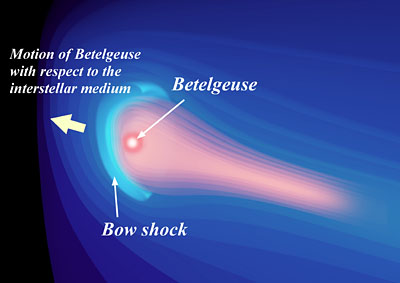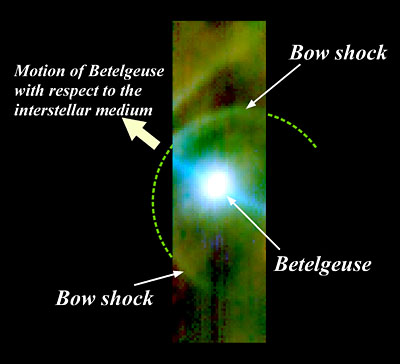[/caption]
You may be familiar with Betelgeuse, as it is the upper-left star in the constellation Orion, forming what would be his shoulder. But this is an image of Betelgeuse that you wouldn’t see with your own eyes or even your own telescope. Images taken with the Akari infrared telescope show that as Betelgeuse travels through the interstellar medium, it creates what is called a “bow shock”.
Betelgeuse (pronounced “beetle-juice”, just like the 80’s film starring Michael Keaton) is a red supergiant 640 light-years from Earth, and is located in the winter constellation Orion. It travels through the interstellar medium at 30 km/sec (19 miles/sec). It’s not the star itself that creates the bow shock, but rather the interaction of the stellar wind emanating from Betelgeuse with the gas in the interstellar medium.
As Betelgeuse plows through the interstellar medium, the wind that it’s spewing out at 17 km/sec (11 miles/sec) warms up the surrounding gas – which originates from star-forming regions in Orion’s Belt – releasing light in the infrared. There is a rather strong current of interstellar gas in the area surrounding Betelegeuse, and just like the wave of water that is produced in front of a boat traveling over a lake, the dust and gas bunches up in front of Betelgeuse in the direction of travel.

The bow shock is approximately 3 light-years across, and the interaction it has with the stellar wind from Betelgeuse gives astronomers a better understanding of the density of the interstellar medium in the region, which in turn can help them get a better picture of the star forming regions in Orion’s Belt that are the source of the gas.
If you turned your telescope towards the Betelgeuse star, you sadly would not be able to see the bow shock. Akari created the image using a composite of images taken at 65 (blue), 90 (green) and 140 (red) micrometers, well below what the human eye can see.
Source: ESA, Bad Astronomy


In cosmological scales is 640 light years that far away? is this observable because it is “close”?
I was mostly curious if our own sun produces an effect like this that would be observable to somebody else “close”. ie: I assume we have our own shell of stellar gas surrounding our own solar system as it is barrelling through the galaxy. If this had a scale of three light years like the betelguise shell would we really be able to persieve it being right in the middle of it all?
We are working on observations of our own shock, particularly, the recently launched IBEX mission, the difference is that from inside, we need to use different more creative tools than viewing from outside.
Because of the zodiacal dust cloud, gegenschein, and the relative distance/size of our own shock from the point of view of earth (it spans a large area of the sky as opposed to viewing another star system’s shock, which from where we are looking fits within a small area of what ever telescope is being used to observe it) we have trouble resolving features that are detailed through the noise of the background (stars, scattered light, etc.. etc.. that spans our entire field of view)
We’re working on it though.